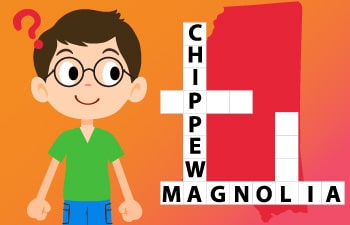Did you know that the Mississippi Delta is the birthplace of blues music, Elvis Presley, and Mississippi Mud Pie? Did you know that some of the sports greatest athletes got their starts in Mississippi colleges, including Eli Manning, Brett Favre, Walter Payton, Jerry Rice, and Steve McNair?
“Mississippi” comes from a Native American word for “great waters,” “father of waters,” or “big river.” Learn more interesting facts about Mississippi, including historical facts about Mississippi, a Mississippi history timeline, geography facts and more in this unit study supplement.
Time4Learning members can download our list of PreK-12 interactive activities that align with your study of Mississippi. Here are a few Mississippi facts for kids:
Mississippi Fast Facts
|
Became a State: |
December 10, 1817 |
|---|---|
|
Order it Joined the Union: |
20th state |
|
State Capital: |
Jackson |
|
State Flag: |

|
|
State Abbreviation: |
MS |
|
Border States: |
|
|
State Song: |
|
|
State Flower: |
Magnolia |
|
State Nickname: |
|
|
Notable Mississippians: |
|
Historical Facts About Mississippi
Let’s start learning some historical facts about Mississippi! Mississippi’s early people arose from three groups of Native Americans: the Choctaw (the largest group) in the southern and central parts of the state, the Natchez in southern Mississippi, and the Chickasaw in the northeastern corner of the state.
The Natchez were nearly eliminated during a war with the French at Fort Rosalie in 1729-1731. The Choctaw and Chickasaw were later removed to the Oklahoma Territory in the 1830s via the Trail of Tears.
Although originally explored by the Spanish, Mississippi was first claimed by France. The area was ceded to the British following the French and Indian War and then was regained by Spain as a result of the American Revolution. In 1789, through an act by the US Congress, Mississippi became part of the Mississippi Territory, which was expanded in 1804 and again in 1812. The western part of the Mississippi Territory then became the state of Mississippi in 1817, with the eastern part becoming Alabama in 1819.
Mississippi’s history of a rural, laid back lifestyle and genteel manners are still reflected throughout the state. Such a culture, however, has slowed economic and social development. By the early 21st century, about half of the population was still living in rural areas, and incomes were low with many people relying on government assistance. Conflict between races made Mississippi a central location for civil rights activism.
Since the mid-20th century, Mississippi has seen growth in employment and wages, and manufacturing and services have expanded, particularly in government, sales, real estate, health and social services, and casinos. There are fewer and smaller farms, and cotton now shares the agricultural scene with livestock, poultry (especially broiler chickens), dairy products, aquaculture (i.e., catfish farming), and crops like sweet potatoes and soybeans.
Despite the changes, the culture of the “planter society” has been weaved throughout Mississippi’s history and is evident in its careful preservation of the past and its focus on the arts. Read the Mississippi history timeline below to learn important Mississippi history facts through the events that occurred in this state.
1519
Spanish explorer, Alonso Alvarez de Pineda, became the first European to map the region1540
Spanish explorer, Hernando de Soto, and a large expedition explored Mississippi, but found no gold or silver (so Spain looked elsewhere)1699
French explorer, Pierre le Moyne d’Iberville, led an expedition and claimed the lower Mississippi valley1763
France lost its possessions east of the Mississippi river (except New Orleans) to Britain, which incorporated part of Mississippi into the colony of West Florida1775-1783
Spain regained possession of Florida and occupied the Natchez area1783
Peace of Paris treaties fixed the 31st parallel as the boundary between the US and Spanish Florida1798
US Congress created the Mississippi Territory; Spain ended its occupation of Natchez1802
Washington became the capital of Mississippi1804
Mississippi Territory was expanded1812
Mississippi Territory was expanded again to include from Tennessee to the Gulf of Mexico1817
Mississippi (the western part of the Mississippi Territory) became the 20th state in the US under President James Madison, with Natchez as the capital1822
Jackson became the capital of Mississippi1861
Mississippi seceded from the union, leading to its involvement in the American Civil War and the destruction of the state’s land and economy1890
State’s constitution emphasized the importance of racial segregation1927
Mississippi River flooded, submerging more than 23,000 square miles of land, displacing hundreds of thousands of people, and killing around 2501936
Mississippi adopted an industrial development program to balance industry with agriculture1955
Emmett Till, a 14-year-old black boy who was accused of whistling at a white woman, was killed in Mississippi by white men who were not punished for the crime1962
US Supreme Court ordered the admission of a black student, James H. Meredith, to the University of Mississippi, ultimately ending the color barrier1964
Ku Klux Klan members killed three civil rights workers near Philadelphia, MS1965
Number of industrial workers surpassed the number of agricultural workers for the first time1969
Mississippi’s school system was desegregated as a result of a federal court orderBring history and geography to life with Time4Learning’s interactive online social studies curriculum for grades 2-12.
Mississippi Geography Facts
The southern state of Mississippi contains lots of wildlife, natural resources, landforms and features. A variety of trees cover about 65 percent of the state, and flowers are abundant, but the wildlife has been reduced by farming and hunting.
However, deer and turkey populations have recovered, and you can also find nine-banded armadillos, swamp rabbits, and various reptiles and amphibians. Birds and sea life (including freshwater species and gulf shrimp, oysters, and fish) are plentiful.
Check out this map of Mississippi to start getting familiar with the state. Then read through the following Mississippi geography facts. Print out the map of Mississippi provided below and add these items to the map.
- Mississippi is bordered by Tennessee in the north, Louisiana and the Gulf of Mexico in the south, Louisiana and Arkansas in the west, and Alabama in the east.
- The capital, Jackson, lies southwest of the center of the state on the Pearl River.
- The Gulf of Mexico borders Mississippi on the eastern half of its southern border.
- The Mississippi River forms the western border of the state.
- The Tombigbee River joins with the Tennessee River to form the Tennessee-Tombigbee Waterway, linking the Tennessee River with the Gulf of Mexico.
- The Pascagoula River is found in the southeastern part of the state.
- The Pearl River is located in the south-central section of Mississippi.
- The Ross Barnett Reservoir is located just northeast of Jackson, near the center of the state.
- Sardis Lake is located in the northwest corner of the state, with the smaller Enid Lake and Grenada Lake found as you move southeast.
- Mississippi is a low area of land with its highest point, Woodall Mountain in the northeast part of the state, at only 807 feet above sea level.
- The lowest point is the Gulf of Mexico, at sea level.
Mississippi State Map
Download our FREE Mississippi state map printable. Use it as a coloring page or use it to plot the state’s geographical features.
Activities for Children in Mississippi
Want to learn more fun facts about Mississippi? Take a trip to one of the state’s interesting locations. Homeschoolers in Mississippi can schedule a day trip while visitors to the state can plan an extended stay. Here are a few ideas to help you learn some Mississippi state facts:
- B.B. King Museum and Delta Interpretive Center (Indianola): Come and celebrate blues music, which is rooted in the Mississippi Delta, through the museum’s films, artifact exhibits, and interactive displays. Honor blues music’s iconic artist, Riley B. King, and try one of the museum’s workshops related to the arts, music, or healthcare. Local children can become involved as Allstars or Ambassadors, and all children can benefit from the museum-based curriculum available for free download on the museum’s website.
- Biloxi Lighthouse and Maritime & Seafood Industry Museum (Biloxi): See one of the first cast-iron lighthouses erected in the South. Built in 1848, it is the city’s landmark and a symbol of strength after Hurricane Katrina. Then explore over 300 years of Mississippi Gulf Coast history and culture at the Maritime & Seafood Industry Museum. Take advantage of exhibits, photographs, and objects related to hurricanes, recreational and commercial fishing, wetlands, marine resource management, shrimping and oystering, charter boats, marine blacksmithing, net making, wooden boat building, catboats, and shrimp peeling machines. You can even go sailing!
- Delta Blues Museum (Clarksdale): Blues lovers will also enjoy this museum that preserves the history of blues music while at the same time allowing current blues musicians to carry on the tradition. See the collection of artifacts including the Muddy Waters cabin, guitars of John Lee Hooker and B.B. King and others, and many examples of recordings, posters, sheet music, costumes, photographs, paintings, and folk art. Check the events calendar for performances and festivals or access the free online “Explore and Learn” educational programs.
- Elvis Presley Birthplace (Tupelo): See the childhood home and church of the “King of Rock ‘n Roll,” the man who merged the blues with popular music, country, and gospel. Walk the trails of the park and visit the Elvis Presley Museum.
- USS Cairo Gunboat and Museum (Vicksburg): See the 1862 USS Cairo, which was recovered in the 1960s and reconstructed in 1977, and then view the thousands of artifacts it held in the USS Cairo Museum. Walk the grounds of Vicksburg National Military Park to see the Civil War battlefield, where the final military action occurred in the Vicksburg campaign, providing control of the Mississippi River to the Union. View the park’s more than 1400 monuments and memorials. Hire a battlefield guide and experience living history events.
Looking for more things to do with your kids in Mississippi? Check out this post full of field trip ideas in Mississippi!
Mississippi Freebies and Deals for Homeschoolers
You can also learn about Mississippi facts and information without spending too much money. Below are just a few ideas:
- Natchez National Historical Park (Natchez): Visit the three properties that are included in the park to learn the history of Natchez beginning with its earliest inhabitants, the “Natchez” American Indians. Kids can earn and collect trading cards at the visitor center. Admission is free to the William Johnson House, Fort Rosalie, and the grounds, outbuildings, and gardens of the Melrose Estate. While there is typically a fee for the guided house tour at the Melrose Estate, check the calendar for fee-free days throughout the year.
- Mississippi Civil Rights Museum (Jackson): Learn about the civil rights movement through the people who led the change. Read the stories, see the artifacts, and interact with the exhibits. Admission to the museum is free on the third Saturday of every month.
- Museum of Mississippi History (Jackson): Examine 15,000 years of Mississippi’s history through the stories and artifacts of the past. Admission to the museum is free on the third Saturday of every month. For those who can’t visit, access the free online learning resources of the Mississippi Department of Archives and History.
Mississippi Learning Games for Children
Now that you have learned some interesting things about Mississippi, test your knowledge of Mississippi facts for students with these free games and activities:












